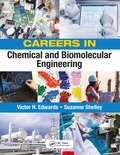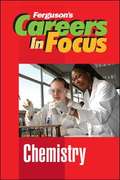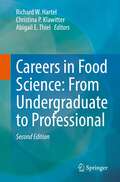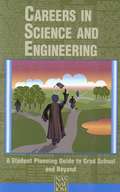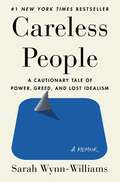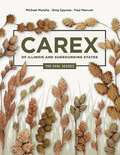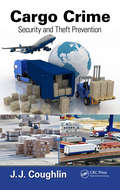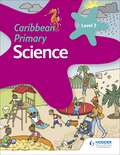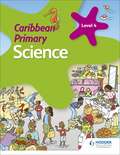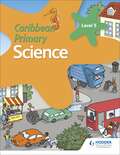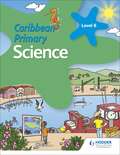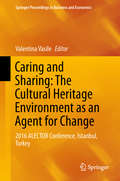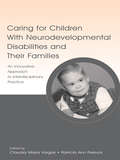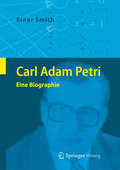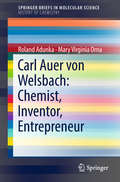- Table View
- List View
Career Planning for Research Bioscientists
by Sarah BlackfordCareer Planning for Research Bioscientists is an essential careers guide for bioscience doctoral students and postdoctoral researchers. It contains a wealth of information and resources specifically targeted at research bioscientists, with practical strategies to enhance career success in an increasingly competitive job market. Advice on how to write a winning CV together with examples adapted for different jobs is presented, as well as practical exercises to assist with skills analysis and decision making. Profiles of PhD-qualified bioscienstists in a range of professions including academic research, industry, science communication, management and consultancy provide valuable insights into how others have managed their careers, and tactics such as networking and using social media demonstrate how new opportunities can be discovered. The content of this book is aimed primarily at research bioscientists, however much of the advice and information will be a useful reference for other students and researchers looking for an effective career planning strategy. A companion website with additional resources is available at www.wiley.com/go/blackford/careerplanning and you can visit Sarah Blackford’s blog at www.biosciencecareers.org for more information.
Careers in Chemical and Biomolecular Engineering
by Victor Edwards Suzanne ShelleyThe scope of opportunities in chemical and biomolecular engineering has grown tremendously in recent years. Careers in Chemical and Biomolecular Engineering conveys the breadth and depth of today’s chemical and biomolecular engineering practice, and describes the intellectually enriching, socially conscious and financially lucrative opportunities available for such graduates in an ever-widening array of industries and applications. This book aims to help students interested in studying chemical engineering and biomolecular engineering to understand the many potential career pathways that are available in these dynamic fields — and is an indispensable resource for the parents, teachers, advisors and guidance counselors who support them, <P><P>In addition to 10 chapters that discuss the roles such graduates play in many diverse industries, this book also features 25 Profile articles that share in-depth, first-person insight from industry-leading chemical and biomolecular engineers. These technical professionals discuss their work and educational experiences (in terms of both triumphs and challenges), and share wisdom and recommendations for students pursuing these two dynamic engineering disciplines.
Careers in Focus: Chemistry
by Ferguson PublishingEverything people need to know in order to get jobs in chemistry-related fields, such as Agricultural Scientists, Biochemists, Chemical Engineers, Chemical Technicians, Chemists, College Professors, Chemistry, Environmental Technicians, Food Technologists, Forensic Experts, Industrial Chemicals Workers, Industrial Safety and Health Technicians, Laboratory Testing Technicians, Medical Laboratory Technicians, Petroleum Engineers, Petroleum Technicians, Pharmacologists, Plastics Engineers, Technicians, Toxicologists, Wood Science and Technology Workers.
Careers in Food Science: From Undergraduate to Professional
by Christina P. Klawitter Richard W. Hartel Abigail E. ThielCareers in Food Science provides detailed guidelines for students and new employees in the food industry to ensure a successful start to their career. Every step towards a rewarding career in this rapidly evolving industry is covered, from which classes to take in college and which degrees to earn, to internships, and finally how to land, and keep, the first job. This book also provides day-to-day examples of what to expect from the many jobs available to help students decide what to do and where to go. This second edition includes nine new chapters covering research chefs, food systems, social justice, food waste, start-ups, sustainability, and management. Several new authors offer fresh perspectives.
Careers in Food Science: From Undergraduate to Professional
by Richard W Hartel Christina P. Klawitter<p><i>Careers in Food Science</i> provides detailed guidelines for students and new employees in the food industry to ensure a successful start to their career. Every step towards a rewarding career in this rapidly evolving industry is covered, from which classes to take in college and which degrees to earn, to internships, and finally how to land, and keep, the first job. This book also provides day-to-day examples of what to expect from the many jobs available to help students decide what to do and where to go. <p>The food industry includes a wide array of fields and careers not only in food production and in academia, but also in government and research institutions. In fact, it is estimated that by 2010 there will be 52,000 annual job openings for college graduates in the Food, Agriculture, and Natural Resources system in the U.S. alone. Written by people who have experience or are currently working in each sector, this book seeks to shed some light on starting, or furthering, a career in this exciting field.</p>
Careers in Science and Engineering: A Student Planning Guide to Grad School and Beyond
by Committee on Science Engineering Public PolicyAs science and technology advance, the needs of employers change, and these changes continually reshape the job market for scientists and engineers. Such shifts present challenges for students as they struggle to make well-informed education and career choices. Careers in Science and Engineering offers guidance to students on planning careers--particularly careers in nonacademic settings--and acquiring the education necessary to attain career goals. This booklet is designed for graduate science and engineering students currently in or soon to graduate from a university, as well as undergraduates in their third or fourth year of study who are deciding whether or not to pursue graduate education. The content has been reviewed by a number of student focus groups and an advisory committee that included students and representatives of several disciplinary societies. Careers in Science and Engineering offers advice on not only surviving but also enjoying a science- or engineering-related education and career-- how to find out about possible careers to pursue, choose a graduate school, select a research project, work with advisers, balance breadth against specialization, obtain funding, evaluate postdoctoral appointments, build skills, and more. Throughout, Careers in Science and Engineering lists resources and suggests people to interview in order to gather the information and insights needed to make good education and career choices. The booklet also offers profiles of science and engineering professionals in a variety of careers. Careers in Science and Engineering will be important to undergraduate and graduate students who have decided to pursue a career in science and engineering or related areas. It will also be of interest to faculty, counselors, and education administrators.
Careless People: A Cautionary Tale of Power, Greed, and Lost Idealism
by Sarah Wynn-Williams#1 New York Times Bestseller“Careless People is darkly funny and genuinely shocking...Not only does [Sarah Wynn-Williams] have the storytelling chops to unspool a gripping narrative; she also delivers the goods." -Jennifer Szalai, The New York Times “When one of the world’s most powerful media companies tries to snuff out a book — amid other alarming attacks on free speech in America like this — it’s time to pull out all the stops.” –Ron Charles, The Washington Post An explosive memoir charting one woman’s career at the heart of one of the most influential companies on the planet, Careless People gives you a front-row seat to Facebook, the decisions that have shaped world events in recent decades, and the people who made them. From trips on private jets and encounters with world leaders to shocking accounts of misogyny and double standards behind the scenes, this searing memoir exposes both the personal and the political fallout when unfettered power and a rotten company culture take hold. In a gripping and often absurd narrative where a few people carelessly hold the world in their hands, this eye-opening memoir reveals what really goes on among the global elite. Sarah Wynn-Williams tells the wrenching but fun story of Facebook, mapping its rise from stumbling encounters with juntas to Mark Zuckerberg’s reaction when he learned of Facebook’s role in Trump’s election. She experiences the challenges and humiliations of working motherhood within a pressure cooker of a workplace, all while Sheryl Sandberg urges her and others to “lean in.” Careless People is a deeply personal account of why and how things have gone so horribly wrong in the past decade—told in a sharp, candid, and utterly disarming voice. A deep, unflinching look at the role that social media has assumed in our lives, Careless People reveals the truth about the leaders of Facebook: how the more power they grasp, the less responsible they become and the consequences this has for all of us.
Carex of Illinois and Surrounding States: The Oval Sedges (Distributed for the Illinois Natural History Survey)
by Michael Murphy Greg Spyreas Paul MarcumA common group of plants in the Midwest’s natural areas, the oval sedges supply food for wildlife while their roots bind the soil and their vegetation creates habitat. Carex of Illinois and Surrounding States: The Oval Sedges offers a guide to the identification, distribution, and natural history of this diverse group of plants. Focused on the Carex section Cyperoideae, the editors cover Illinois’ twenty-five species, every oval sedge in Indiana and Kentucky, and nearly every species in Iowa, Michigan, Missouri, and Wisconsin. A two-step process helps users recognize the notoriously difficult-to-identify plants while illustrations and labeled photographs aid users in evaluating morphological characteristics. The editors also furnish first-ever distribution maps for Illinois’ recently described species and varieties plus up-to-date maps for nearly every other species. Drawing on the study of thousands of specimens, Carex of Illinois and Surrounding States: The Oval Sedges is an invaluable resource for botanists, ecologists, environmental engineers, and professional and amateur environmentalists interested in a deeper understanding of these essential plants.
Cargo Crime: Security and Theft Prevention
by John J. CoughlinCargo crime including theft, fraud, and the passage of contraband through commercial shipping lanes poses an enormous threat to security and the economy. By understanding the current methods and operations of those who attack the supply chain, industry professionals can design effective security plans and law enforcement can properly investigate th
Caribbean Primary Science Book 3
by Karen Morrison Lorraine DeAllie Lisa Greenstein Sally Knowlman Susan CrumptonOpen up the world of science to your students, enthusing and encouraging them to become focused, questioning and successful scientists, thinkers and problem-solvers.Science and technology encompass some of the most important skills children need to master in the modern world. This series introduces and develops the building blocks of science study, ensuring student interest and academic progression continue hand-in-hand throughout the primary school and on into secondary education.- new, appealing resource planned and designed to make each student feel and work like a scientist- language controlled with vocabulary support for students, plus full support for non-specialist teachers- features special projects and research projects to build skills towards the end of primary examinations- focus on practical work, green technologies, environmental issues and science in daily life.
Caribbean Primary Science Book 3 (Caribbean Primary Science)
by Karen Morrison Lorraine DeAllie Lisa Greenstein Sally Knowlman Susan CrumptonOpen up the world of science to your students, enthusing and encouraging them to become focused, questioning and successful scientists, thinkers and problem-solvers.Science and technology encompass some of the most important skills children need to master in the modern world. This series introduces and develops the building blocks of science study, ensuring student interest and academic progression continue hand-in-hand throughout the primary school and on into secondary education.- new, appealing resource planned and designed to make each student feel and work like a scientist- language controlled with vocabulary support for students, plus full support for non-specialist teachers- features special projects and research projects to build skills towards the end of primary examinations- focus on practical work, green technologies, environmental issues and science in daily life.
Caribbean Primary Science Book 4
by Karen Morrison Lorraine DeAllie Sally Knowlman Susan CrumptonOpen up the world of science to your students, enthusing and encouraging them to become focused, questioning and successful scientists, thinkers and problem-solvers. Science and technology encompass some of the most important skills children need to master in the modern world. This series introduces and develops the building blocks of science study, ensuring student interest and academic progression continue hand-in-hand throughout the primary school and on into secondary education.- new, appealing resource planned and designed to make each student feel and work like a scientist- language controlled with vocabulary support for students, plus full support for non-specialist teachers- features special projects and research projects to build skills towards the end of primary examinations- focus on practical work, green technologies, environmental issues and science in daily life.
Caribbean Primary Science Book 4 (Caribbean Primary Science)
by Karen Morrison Lorraine DeAllie Sally Knowlman Susan CrumptonOpen up the world of science to your students, enthusing and encouraging them to become focused, questioning and successful scientists, thinkers and problem-solvers. Science and technology encompass some of the most important skills children need to master in the modern world. This series introduces and develops the building blocks of science study, ensuring student interest and academic progression continue hand-in-hand throughout the primary school and on into secondary education.- new, appealing resource planned and designed to make each student feel and work like a scientist- language controlled with vocabulary support for students, plus full support for non-specialist teachers- features special projects and research projects to build skills towards the end of primary examinations- focus on practical work, green technologies, environmental issues and science in daily life.
Caribbean Primary Science Book 5
by Karen Morrison Lorraine DeAllie Sally KnowlmanOpen up the world of science to your students, enthusing and encouraging them to become focused, questioning and successful scientists, thinkers and problem-solvers. Science and technology encompass some of the most important skills children need to master in the modern world. This series introduces and develops the building blocks of science study, ensuring student interest and academic progression continue hand-in-hand throughout the primary school and on into secondary education.- new, appealing resource planned and designed to make each student feel and work like a scientist- language controlled with vocabulary support for students, plus full support for non-specialist teachers- features special projects and research projects to build skills towards the end of primary examinations- focus on practical work, green technologies, environmental issues and science in daily life.
Caribbean Primary Science Book 5 (Caribbean Primary Science)
by Karen Morrison Lorraine DeAllie Lisa Greenstein Sally Knowlman Susan Crumpton Milly FullickOpen up the world of science to your students, enthusing and encouraging them to become focused, questioning and successful scientists, thinkers and problem-solvers. Science and technology encompass some of the most important skills children need to master in the modern world. This series introduces and develops the building blocks of science study, ensuring student interest and academic progression continue hand-in-hand throughout the primary school and on into secondary education.- new, appealing resource planned and designed to make each student feel and work like a scientist- language controlled with vocabulary support for students, plus full support for non-specialist teachers- features special projects and research projects to build skills towards the end of primary examinations- focus on practical work, green technologies, environmental issues and science in daily life.
Caribbean Primary Science Book 6
by Catherine Jones Karen Morrison Lorraine DeAllie Lisa GreensteinOpen up the world of science to your students, enthusing and encouraging them to become focused, questioning and successful scientists, thinkers and problem-solvers. Science and technology encompass some of the most important skills children need to master in the modern world. This series introduces and develops the building blocks of science study, ensuring student interest and academic progression continue hand-in-hand throughout the primary school and on into secondary education.- new, appealing resource planned and designed to make each student feel and work like a scientist- language controlled with vocabulary support for students, plus full support for non-specialist teachers- features special projects and research projects to build skills towards the end of primary examinations- focus on practical work, green technologies, environmental issues and science in daily life.
Caribbean Primary Science Book 6 (Caribbean Primary Science)
by Catherine Jones Karen Morrison Lorraine DeAllie Lisa GreensteinOpen up the world of science to your students, enthusing and encouraging them to become focused, questioning and successful scientists, thinkers and problem-solvers. Science and technology encompass some of the most important skills children need to master in the modern world. This series introduces and develops the building blocks of science study, ensuring student interest and academic progression continue hand-in-hand throughout the primary school and on into secondary education.- new, appealing resource planned and designed to make each student feel and work like a scientist- language controlled with vocabulary support for students, plus full support for non-specialist teachers- features special projects and research projects to build skills towards the end of primary examinations- focus on practical work, green technologies, environmental issues and science in daily life.
Caring and Sharing: 2016 ALECTOR Conference, Istanbul, Turkey (Springer Proceedings in Business and Economics)
by Valentina VasileThis proceedings volume explores the socio-economic dimension of the heritage sector from a broad, interdisciplinary perspective. Featuring contributions from the 2016 ALECTOR International Conference held in Istanbul, Turkey, this book presents current theoretical and empirical research related to such topics as: R&D and ICT in tourism; heritage products and services; climate change; finance and tourism; cultural communication; anthropological cultural heritage; and heritage management. Collectively, the papers presented in this book provides methodologies, strategies and applications to measure the socio-economic dimension of the heritage sector and also good practices in the heritage sector that drive regional, cultural and economic development and sustainability. The EU Neighbourhood Info Centre (ENPI) Cross-Border Cooperation (CBC) Black Sea project “Collaborative Networks of Multilevel Actors to Advance Quality Standards for Heritage Tourism at Cross Border Level”, or ALECTOR, focuses on different types of heritage assets as a means to invest in human capital and tourism innovation in order to achieve socio-economic development and cooperation with social partners in the Black Sea region. Featuring collaborations from Greece, Romania, Bulgaria, Moldova Ukraine, Georgia and Turkey, the project proposes a cognitive and educational framework for using a region’s assets, which would guide final beneficiaries (regions, communities, SMEs) to identify, signify, valorize and manage their natural and cultural resources, in order to use heritage potential as a vehicle for tourism. Presenting case studies of successful initiatives, the enclosed papers are divided into two parts: • Part I: Economics of Heritage features innovative research results on the heritage and tourism topics from countries such as Bulgaria, Croatia, Russia, and Romania • Part II: Best Practices features best practices, experiences, and promotion plans for cultural heritage through tourism from countries such as Bulgaria, Republic of Moldova, Turkey, Russia, and Romania
Caring for Children With Neurodevelopmental Disabilities and Their Families: An Innovative Approach to Interdisciplinary Practice
by Claudia María VargasChildren with neurodevelopmental disabilities such as mental retardation or autism present multiple challenges to their families, health care providers, and teachers. Professionals consulted by desperate parents often see the problems from their own angle only and diagnosis and intervention efforts wind up fragmented and ineffective. This book presents a model multidisciplinary approach to care--family-centered and collaborative--that has proven effective in practice. A pillar of the approach is recognition of the importance of performing culturally competent assessment and adjusting service delivery so that is responsive to cultural differences. Detailed case stories illuminate the ways in which the approach can help children with different backgrounds and different disabilities. Most chapters include study questions, lists of resources, and glossaries to facilitate easy comprehension by professionals with different backgrounds--in special education, communication sciences, and disorders, clinical and counseling psychology, neuropsychology and psychiatry, social work, pediatrics--and program administrators as well as students, trainees and educated parents. Caring for Children With Neurodevelopmental Disabilities and Their Families constitutes a crucial new resource for all those professionally and personally concerned with these children.
Carl Adam Petri: Eine Biographie
by Einar SmithDer Autor präsentiert Leben, Werk und Wirken eines der weltweit bekanntesten deutschen Informatiker: Carl Adam Petri. Die Stadien seiner Entwicklung sind lebendig und kurzweilig beschrieben, gehen aber so weit in die Tiefe, dass der Leser ein gutes Verständnis für die Hintergründe von Petris wichtigstem Beitrag zur Informatik bekommt, die nach ihm benannten Petrinetze. Das Buch kann so als Einführung in die Petrinetze gelesen werden, erörtert aber auch die theoretischen, physikalischen und philosophischen Grundlagen der Netze, die erst einen umfassenden Zugang zu Petris Werk ermöglichen. Das Buch wendet sich dank seiner verständlichen Darstellung aber auch an Leser, die einfach nur eine bemerkenswerte Persönlichkeit der Zeitgeschichte kennenlernen möchten.
Carl Auer von Welsbach: Chemist, Inventor, Entrepreneur (Springerbriefs In Molecular Science)
by Mary Virginia Orna Roland AdunkaThis Brief documents the life, discoveries and inventions of the chemist Carl Auer von Welsbach. Particular attention is given to his pioneering work on the rare earth elements, including the discovery of four new elements, which allowed him to develop new materials, to invent new useful devices and to establish major industries. From the invention of the incandescent gas mantle and first electric incandescent lamps with metal filaments to the first mass production of radium from pitchblende residues, readers will learn the story of his notable legacy to the word through the lens of his rare earths knowledge.
Carl Friedrich von Weizsäcker: Major Texts On Politics And Peace Research (SpringerBriefs on Pioneers in Science and Practice #25)
by Ulrich BartoschThis book offers a collection of texts by Carl Friedrich von Weizsaecker (1912-2007), a major German universal scientist who was also a pioneer in physics, philosophy, religion on issues of politics and peace research. He worked with Werner Heisenberg and Otto Hahn in the German "Uranverein", obtained a patent for plutonium during World War II and was an opponent of the nuclear armament of the German armed forces (1957). Furthermore, he published a study on the inability to defend Germany (1971) that was instrumental in the debate on defensive defense since the mid 1970s. He wrote on war and peace, peace and truth, policy implications of nuclear energy, on ethical issues of modern strategy, on consequences of war and war prevention and on the theory of power. He coined the term "world domestic policy" which still covers a valid theory for political, institutional secured world peace in the atomic age.
Carl Friedrich von Weizsäcker: Major Texts On Religion (SpringerBriefs on Pioneers in Science and Practice #24)
by Konrad RaiserThis book presents a collection of texts by the German physicist and philosopher Carl Friedrich von Weizsäcker (1912-2007) in English, for use in seminars on the philosophy of religion, the comparative study of religion, but as well on the relationship between religion and the scientific worldview. Most texts appear in English for the first time. Weizsäcker became famous through his works in physics, mainly in the early development of nuclear physics. Later he would also become well known as a philosopher and analyst of contemporary culture. He also worked very intensely on projects for the prevention of nuclear war and for peace in general.
Carl Friedrich von Weizsäcker: Major Texts in Philosophy (SpringerBriefs on Pioneers in Science and Practice #23)
by Michael DrieschnerThis book presents a collection of texts by the German philosopher and physicist Carl Friedrich von Weizsäcker (1912-2007), for use in seminars on philosophy, mainly epistemology and the philosophy of physics or foundations of quantum mechanics, but also for courses on German philosophy of the 20th century or the philosophy of science. Most texts appear in English for the first time. Weizsäcker became famous through his works in physics, later becoming well known as a philosopher and an analyst of contemporary culture and politics. He worked intensively on projects for the prevention of nuclear war and for peace in general. - Texts about classical philosophy are included as well as on logic, on the philosophy of biology and on the philosophy of mathematics, on "death" as well as on "power".
Carl Friedrich von Weizsäcker: Major Texts in Physics (SpringerBriefs on Pioneers in Science and Practice #22)
by Michael DrieschnerThis book presents a collection of texts by the German physicist and philosopher Carl Friedrich von Weizsäcker (1912-2007), for use in seminars on the history, epistemology and structure of physics. Most texts appear in English for the first time. Weizsäcker became famous through his works in physics, mainly in the early development of nuclear physics. Later he would also become well known as a philosopher and analyst of contemporary culture. Texts include the original publications of the "Weizsäcker-Bethe formula" of nuclear masses and the "Bethe-Weizsäcker cycle," which explains the source of energy in the sun; both were developed by Bethe at the same time and independently of Weizsäcker. Further texts deal with Weizsäcker's explanation of the origin of planets, his explanation of the "time arrow" in Statistical Mechanics and his analyses of Quantum Mechanics and the structure of physics in general.

